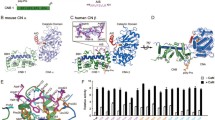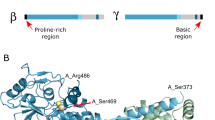Abstract
Calcineurin (CN) is a heterodimer, composed of a catalytic subunit (CNA) and a regulatory subunit (CNB). There are four functional domains present in CNA, which are catalytic domain (CNa), CNB-binding domain (BBH), CaM-binding domain (CBH) and autoinhibitory domain (AI). It has been shown previously that the in vitro activity of calcineurin is relied primarily on the binding of metal ions. Mn2+ and Ni2+ are the most crucial cation-activators for this enzyme. In order to determine which domain(s) in CN is functionally regulated by metal ions, the rat CNA α subunit and its catalytic domain (CNa) were cloned and expressed in E. coli. The effects of Mn2+, Ni2+ and Mg2+ on the catalytic activity of these purified proteins were examined. Our results demonstrate that all the metal ions tested in this study activated either CNA or CNa. However, the activation degree of CNa by the metal ions was much higher than that of CNA. In term of different metal ions, the activating extents to CNA and CNa were different. To CNA, the activating order from high to low was Mg2+>>Ni2+>Mn2+, but Mn2+>Ni2+>>Mg2+ to CNa. No effect of CaM/Ca2+ and CNB/Ca2+ on the activity of CNa was observed in our experiments. Moreover, a weak interaction (or untight coordination binding) between metal ions and the enzyme molecule was also identified. These results suggest that the activation of these enzymes by the exogenous metal ions might be via both regulating fragment of CNA (including BBH, CBH and AI) and catalytic domain (CNa), and mainly via regulating fragment to CNA and mainly via catalytic domain to CNa. The activating extents of metal ions via catalytic domain were higher than that via regulating fragment. The results obtained in this study should be very useful for understanding the molecular mechanism underlying the interaction between calcineurin and metal ions, especially Mn2+, Ni2+ and Mg2+.
Similar content being viewed by others
References
Chernoff J, Sells MA, Li H-C. 1984 Characterization of phosphotyrosyl-protein phosphatase activity associated with calcineurin. Biochem Biophys Res Commun 121, 141-148.
Goldberg J, Huang H, Kwon Y, Greengard P, Nairn AC, Kuriyan J. 1995 Three-dimensional structure of the catalytic subunit of protein serine/threonine phosphatase-1. Nature 376, 745-753.
Griffith JP, Kim JL, Kim EE, Sintchak MD, Thomson JA, Fitzgibbon MJ, Fleming MA, Caron PR, Hsiao K, Navia MA. 1995 X-ray structure of calcineurin inhibited by the immunophilinimmunosuppressant FKBP12-FK506 complex. Cell 82, 507-522.
Hubbard MJ, Klee CB. 1989 Functional domain structure of calcineurin A: mapping by limited proteolysis. Biochemistry 28, 1868-1874.
Klee CB, Krinks MH, Manalan AS, Cohen P, Stewart AA. 1983 Isolation and characterization of bovine brain calcineurin:a calmodulin-stimulated protein phosphatase. Methods Enzymol. 102, 227-244.
Landner CJ, Czeeh J, Maurice J, Lorens SA, Lee JM. 1996 Reduction of calcineurin enzymatic activity in Alzheimer's disease: correlation with neuropathologic changes. J Neuropathol Exp Neurol 55, 924-931.
Leslic AL. 2001 Calcineurin inhibition and cardac hypertrophy: A matter of balance. PANS 98(6), 2947-2949.
Li H-C, Chan WWS. 1984 Activation of brain calcineurin towards proteins containing thr(P) and ser(P) by Ca2+, calmodulin, Mg2+ and transition metal ions. Eur. J. Biochem. 144, 447-452.
Li H-C. 1984 Activation of brain calcineurin phosphatase towards nonprotein phosphoesters by Ca2+, calmodulin, and Mg2+. J Biol Chem 259, 8801-8807.
Martin BL, Jurado LA, Hengge AC. 1999 Comparison of the reaction progress of calcineurin with Mn2+ and Mg2+. Biochemistry 38, 3386-3392.
Martin BL, Rhode DJ. 1999 Effect of substitution inert metal complexes on calcineurin. Arch Biochem Biophys 366, 168-176.
Martin BL, Jurado LA. 1998 Activation of calcineurin by the trivalent metal terbium. J Protein Chem 17, 473-478.
Merat DL, Hu ZY, Carter TE, Cheung WY. 1984 Subunit A of calmodulin-dependent protein phosphatase requires Mn2+ for activity. Biochem Biophys Res Commun 122, 1389-1396.
Pallen CJ, Wang JH. 1984 Regulation of calcineurin by metal ions. J. Biol. Chem. 259, 6134-6141.
Pallen CJ, Wang JH. 1986 Stoichiometry and dynamic interactions of metal ion activators with calcineurin phosphatase. J BiolChem 261, 16115-16120.
Rusnak F, Mertz P. 2000 Calcineurin: Form and Function. Physiol Rev 80(4), 1483-1521.
Sikkink R, Haddy A, Mackelvie S, Mertz P, Litwiller R, Rusnak F. 1995 Calcineurin subunit interactions: Mapping the calcineurin B binding domain on calcineurin A. Biochemistry 34, 8348-8356.
Thomas CF, Keith MS, James RM, Christopher MN, Ashok K. 2001 Calcineurin links Ca2+ dysregulation with brain aging. J NeuroSci 21(11), 4066-4073.
Valerie H, Grace KP. 2002 NFAT: Ubiquitous regulator of cell differentiation and adaptation. J Cell Biol 156(5), 771-774.
Wei Q, Lee EYC. 1997 Expression and reconstitution of calcineurin A and B subunits. Biochem Mol Biol Interl 41(1), 169-177.
Author information
Authors and Affiliations
Corresponding author
Rights and permissions
About this article
Cite this article
Ping, L., Ke, Z., Benqiong, X. et al. Effect of metal ions on the activity of the catalytic domain of calcineurin. Biometals 17, 157–165 (2004). https://doi.org/10.1023/B:BIOM.0000018373.85342.36
Issue Date:
DOI: https://doi.org/10.1023/B:BIOM.0000018373.85342.36




